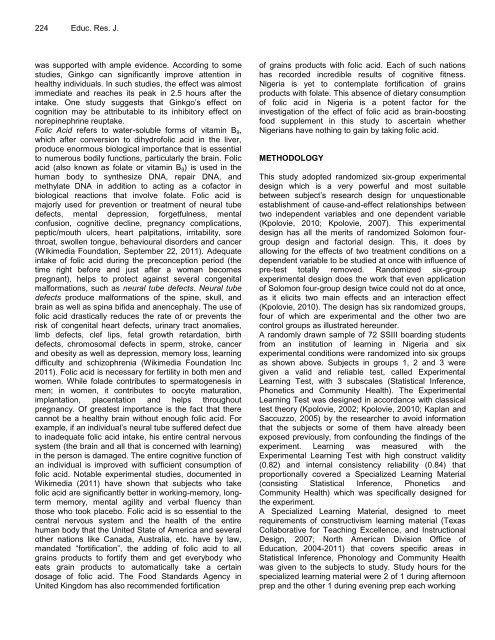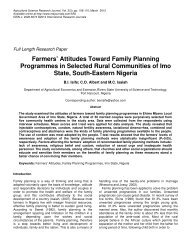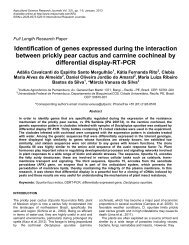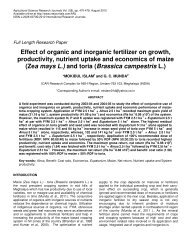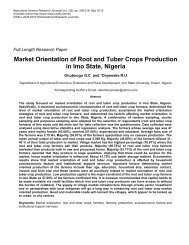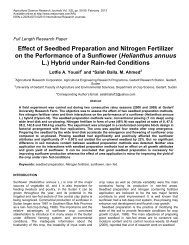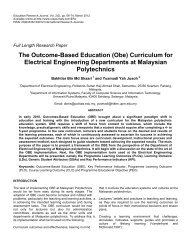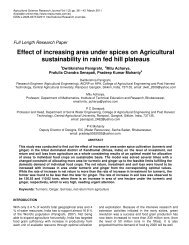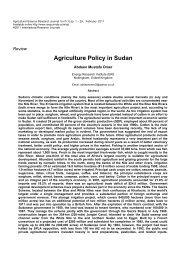Lumosity training and brain-boosting food effects on learning
Lumosity training and brain-boosting food effects on learning
Lumosity training and brain-boosting food effects on learning
- No tags were found...
Create successful ePaper yourself
Turn your PDF publications into a flip-book with our unique Google optimized e-Paper software.
224 Educ. Res. J.was supported with ample evidence. According to somestudies, Ginkgo can significantly improve attenti<strong>on</strong> inhealthy individuals. In such studies, the effect was almostimmediate <str<strong>on</strong>g>and</str<strong>on</strong>g> reaches its peak in 2.5 hours after theintake. One study suggests that Ginkgo’s effect <strong>on</strong>cogniti<strong>on</strong> may be attributable to its inhibitory effect <strong>on</strong>norepinephrine reuptake.Folic Acid refers to water-soluble forms of vitamin B 9 ,which after c<strong>on</strong>versi<strong>on</strong> to dihydrofolic acid in the liver,produce enormous biological importance that is essentialto numerous bodily functi<strong>on</strong>s, particularly the <str<strong>on</strong>g>brain</str<strong>on</strong>g>. Folicacid (also known as folate or vitamin B 9 ) is used in thehuman body to synthesize DNA, repair DNA, <str<strong>on</strong>g>and</str<strong>on</strong>g>methylate DNA in additi<strong>on</strong> to acting as a cofactor inbiological reacti<strong>on</strong>s that involve folate. Folic acid ismajorly used for preventi<strong>on</strong> or treatment of neural tubedefects, mental depressi<strong>on</strong>, forgetfulness, mentalc<strong>on</strong>fusi<strong>on</strong>, cognitive decline, pregnancy complicati<strong>on</strong>s,peptic/mouth ulcers, heart palpitati<strong>on</strong>s, irritability, sorethroat, swollen t<strong>on</strong>gue, behavioural disorders <str<strong>on</strong>g>and</str<strong>on</strong>g> cancer(Wikimedia Foundati<strong>on</strong>, September 22, 2011). Adequateintake of folic acid during the prec<strong>on</strong>cepti<strong>on</strong> period (thetime right before <str<strong>on</strong>g>and</str<strong>on</strong>g> just after a woman becomespregnant), helps to protect against several c<strong>on</strong>genitalmalformati<strong>on</strong>s, such as neural tube defects. Neural tubedefects produce malformati<strong>on</strong>s of the spine, skull, <str<strong>on</strong>g>and</str<strong>on</strong>g><str<strong>on</strong>g>brain</str<strong>on</strong>g> as well as spina bifida <str<strong>on</strong>g>and</str<strong>on</strong>g> anencephaly. The use offolic acid drastically reduces the rate of or prevents therisk of c<strong>on</strong>genital heart defects, urinary tract anomalies,limb defects, clef lips, fetal growth retardati<strong>on</strong>, birthdefects, chromosomal defects in sperm, stroke, cancer<str<strong>on</strong>g>and</str<strong>on</strong>g> obesity as well as depressi<strong>on</strong>, memory loss, <strong>learning</strong>difficulty <str<strong>on</strong>g>and</str<strong>on</strong>g> schizophrenia (Wikimedia Foundati<strong>on</strong> Inc2011). Folic acid is necessary for fertility in both men <str<strong>on</strong>g>and</str<strong>on</strong>g>women. While folade c<strong>on</strong>tributes to spermatogenesis inmen; in women, it c<strong>on</strong>tributes to oocyte maturati<strong>on</strong>,implantati<strong>on</strong>, placentati<strong>on</strong> <str<strong>on</strong>g>and</str<strong>on</strong>g> helps throughoutpregnancy. Of greatest importance is the fact that therecannot be a healthy <str<strong>on</strong>g>brain</str<strong>on</strong>g> without enough folic acid. Forexample, if an individual’s neural tube suffered defect dueto inadequate folic acid intake, his entire central nervoussystem (the <str<strong>on</strong>g>brain</str<strong>on</strong>g> <str<strong>on</strong>g>and</str<strong>on</strong>g> all that is c<strong>on</strong>cerned with <strong>learning</strong>)in the pers<strong>on</strong> is damaged. The entire cognitive functi<strong>on</strong> ofan individual is improved with sufficient c<strong>on</strong>sumpti<strong>on</strong> offolic acid. Notable experimental studies, documented inWikimedia (2011) have shown that subjects who takefolic acid are significantly better in working-memory, l<strong>on</strong>gtermmemory, mental agility <str<strong>on</strong>g>and</str<strong>on</strong>g> verbal fluency thanthose who took placebo. Folic acid is so essential to thecentral nervous system <str<strong>on</strong>g>and</str<strong>on</strong>g> the health of the entirehuman body that the United State of America <str<strong>on</strong>g>and</str<strong>on</strong>g> severalother nati<strong>on</strong>s like Canada, Australia, etc. have by law,m<str<strong>on</strong>g>and</str<strong>on</strong>g>ated “fortificati<strong>on</strong>”, the adding of folic acid to allgrains products to fortify them <str<strong>on</strong>g>and</str<strong>on</strong>g> get everybody whoeats grain products to automatically take a certaindosage of folic acid. The Food St<str<strong>on</strong>g>and</str<strong>on</strong>g>ards Agency inUnited Kingdom has also recommended fortificati<strong>on</strong>of grains products with folic acid. Each of such nati<strong>on</strong>shas recorded incredible results of cognitive fitness.Nigeria is yet to c<strong>on</strong>template fortificati<strong>on</strong> of grainsproducts with folate. This absence of dietary c<strong>on</strong>sumpti<strong>on</strong>of folic acid in Nigeria is a potent factor for theinvestigati<strong>on</strong> of the effect of folic acid as <str<strong>on</strong>g>brain</str<strong>on</strong>g>-<str<strong>on</strong>g>boosting</str<strong>on</strong>g><str<strong>on</strong>g>food</str<strong>on</strong>g> supplement in this study to ascertain whetherNigerians have nothing to gain by taking folic acid.METHODOLOGYThis study adopted r<str<strong>on</strong>g>and</str<strong>on</strong>g>omized six-group experimentaldesign which is a very powerful <str<strong>on</strong>g>and</str<strong>on</strong>g> most suitablebetween subject’s research design for unquesti<strong>on</strong>ableestablishment of cause-<str<strong>on</strong>g>and</str<strong>on</strong>g>-effect relati<strong>on</strong>ships betweentwo independent variables <str<strong>on</strong>g>and</str<strong>on</strong>g> <strong>on</strong>e dependent variable(Kpolovie, 2010; Kpolovie, 2007). This experimentaldesign has all the merits of r<str<strong>on</strong>g>and</str<strong>on</strong>g>omized Solom<strong>on</strong> fourgroupdesign <str<strong>on</strong>g>and</str<strong>on</strong>g> factorial design. This, it does byallowing for the <str<strong>on</strong>g>effects</str<strong>on</strong>g> of two treatment c<strong>on</strong>diti<strong>on</strong>s <strong>on</strong> adependent variable to be studied at <strong>on</strong>ce with influence ofpre-test totally removed. R<str<strong>on</strong>g>and</str<strong>on</strong>g>omized six-groupexperimental design does the work that even applicati<strong>on</strong>of Solom<strong>on</strong> four-group design twice could not do at <strong>on</strong>ce,as it elicits two main <str<strong>on</strong>g>effects</str<strong>on</strong>g> <str<strong>on</strong>g>and</str<strong>on</strong>g> an interacti<strong>on</strong> effect(Kpolovie, 2010). The design has six r<str<strong>on</strong>g>and</str<strong>on</strong>g>omized groups,four of which are experimental <str<strong>on</strong>g>and</str<strong>on</strong>g> the other two arec<strong>on</strong>trol groups as illustrated hereunder.A r<str<strong>on</strong>g>and</str<strong>on</strong>g>omly drawn sample of 72 SSIII boarding studentsfrom an instituti<strong>on</strong> of <strong>learning</strong> in Nigeria <str<strong>on</strong>g>and</str<strong>on</strong>g> sixexperimental c<strong>on</strong>diti<strong>on</strong>s were r<str<strong>on</strong>g>and</str<strong>on</strong>g>omized into six groupsas shown above. Subjects in groups 1, 2 <str<strong>on</strong>g>and</str<strong>on</strong>g> 3 weregiven a valid <str<strong>on</strong>g>and</str<strong>on</strong>g> reliable test, called ExperimentalLearning Test, with 3 subscales (Statistical Inference,Ph<strong>on</strong>etics <str<strong>on</strong>g>and</str<strong>on</strong>g> Community Health). The ExperimentalLearning Test was designed in accordance with classicaltest theory (Kpolovie, 2002; Kpolovie, 20010; Kaplan <str<strong>on</strong>g>and</str<strong>on</strong>g>Saccuzzo, 2005) by the researcher to avoid informati<strong>on</strong>that the subjects or some of them have already beenexposed previously, from c<strong>on</strong>founding the findings of theexperiment. Learning was measured with theExperimental Learning Test with high c<strong>on</strong>struct validity(0.82) <str<strong>on</strong>g>and</str<strong>on</strong>g> internal c<strong>on</strong>sistency reliability (0.84) thatproporti<strong>on</strong>ally covered a Specialized Learning Material(c<strong>on</strong>sisting Statistical Inference, Ph<strong>on</strong>etics <str<strong>on</strong>g>and</str<strong>on</strong>g>Community Health) which was specifically designed forthe experiment.A Specialized Learning Material, designed to meetrequirements of c<strong>on</strong>structivism <strong>learning</strong> material (TexasCollaborative for Teaching Excellence, <str<strong>on</strong>g>and</str<strong>on</strong>g> Instructi<strong>on</strong>alDesign, 2007; North American Divisi<strong>on</strong> Office ofEducati<strong>on</strong>, 2004-2011) that covers specific areas inStatistical Inference, Ph<strong>on</strong>ology <str<strong>on</strong>g>and</str<strong>on</strong>g> Community Healthwas given to the subjects to study. Study hours for thespecialized <strong>learning</strong> material were 2 of 1 during afterno<strong>on</strong>prep <str<strong>on</strong>g>and</str<strong>on</strong>g> the other 1 during evening prep each working


